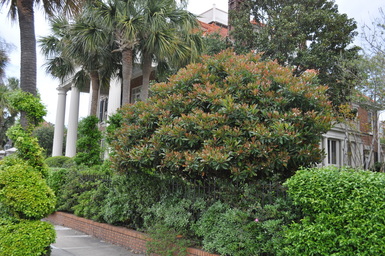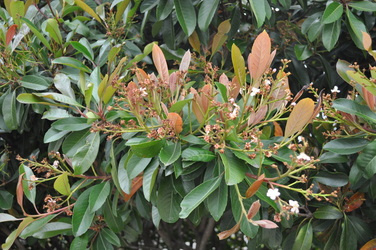The Genus Eriobotrya
Family Rosaceae
This is a medium-sized genus of evergreen shrubs and trees native to Asia. One species is widely cultivated in warm climates for its edible fruit.
The rose family, Rosaceae, includes herbaceous plants, shrubs, trees and vines. It includes agricultural crops like Indian hawthorn (Raphiolepsis,) strawberry (Fragaria,) apple (Malus,) plum, cherry and apricot (Prunus,) pear (Pyrus,) and blackberry and raspberry (Rubus.) Ornamental plants include redtip (Photinia) and spiraea (Spiraea.)
Eriobotrya deflexa
bronze loquat
This is an evergreen tree that grows to a height of about twenty feet tall. The bark is smooth and gray. New leaves are a distinctive bronze-red color. Large clusters of white flowers are produced in spring. The fruits are small and are reported to inedible. It requires a moist, well-drained soil, sun and good air circulation. It is reported to grow from zone 8b to 10.
This plant is available from specialty nurseries. It is propagated by seeds and cuttings.
I have not grown this plant yet. I have seen nice specimens in Savannah, Georgia and Charleston, South Carolina.
Eriobotrya japonica
loquat, Japanese plum
This is a medium-sized, evergreen tree to about thirty feet tall. It has a thin, gray bark. It has spikes of small, fragrant white flowers in fall and winter. It produces edible, sweet, orange fruits in spring. It is drought tolerant and requires a well-drained soil. The plant is popular in the region’s gardens. It is reported to be moderately salt tolerant. This plant is recommended for zone 8 and south. Fruit flies are pests in the southern part of its range.
Loquat has escaped cultivation in southern and central Florida. When growing it for fruit production in the Coastal Southeast, it should be managed to control its spread.
This plant is available in local nurseries. They are grown from seed. Named cultivars are available in fruit tree catalogs. Usually, these plants are grafted. They may be propagated by air layers, also.
My plant produces new growth in mid- to late February to late March. The old leaves fall shortly afterwards. It flowers between August and December. In several years in my garden, freezes have killed the flowers or young fruits every year. Recently, I ordered a selection, ‘Gold Nugget,’ from a nursery in Georgia. This cultivar is supposed to produce flowers and fruits later in the spring. ‘Coppertone’ is a selection that has leaves with a copper-colored underside. Some suspect that it is a hybrid.



